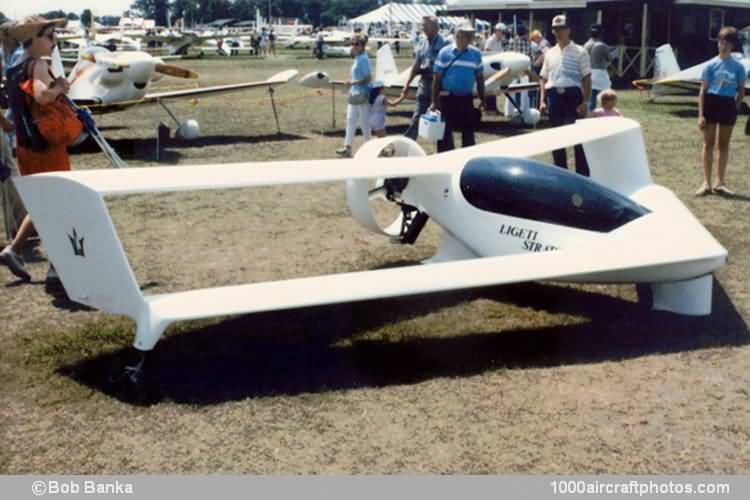The single-seat all-composite joined-wing ducted fan Stratos micro-light was conceived in 1982, to combine the efficiency of a canard, the large wing area and small span of a tandem wing configuration, and the strength of an externally braced biplane. It had a 120° sweptback foreplane joined with the high-mounted main-plane at the tips by vertical split rudders, this gave increased wing stiffness and better pilot protection. The reductions in both weight and induced drag made the aerodynamically clean configuration suitable for soaring.
Prototype construction was started in May 1983, after extensive testing of the concept in quarter-scale radio controlled and free flight model forms, and it made a 45 minute first flight on 25 April 1985, piloted by Mr Ligeti, who reported subsequently that it fulfilled or exceeded all performance expectations. Ligeti Aero-Nautical Pty. Ltd. was established in the same year and in 1986 the Stratos was flown to the USA aboard a Qantas Boeing 747 and demonstrated at the EAA Fly-In at Oshkosh, the Seattle Air Fair and in Canada at the Vancouver World Expo.
By that time 200 orders had been placed for the small Stratos that could be transported fully assembled on a trailer behind a car, and kept in an average family garage, eliminating assembly and dismantling. Plans, prefabricated component parts and kits were expected to be made available, incorporating several refinements over the prototype, such as a larger cockpit and increased fuel capacity. A two-seat Stratos was expected to make its first flight in 1987.
The Stratos had an all-composites structure of Kevlar and glass fiber skins over shaped rigid foam, with carbon fiber spars. It had three-axis control, pitch control by elevator on foreplane; roll control by ailerons on foreplane and main plane, while wing tip split rudders provided yaw control when used differentially and acted as airbrakes when used collectively. It had a non-retractable landing gear, with two main wheels in tandem and two balancer wheels at wing tips, and a steerable front wheel.
The prototype was powered by a 28 hp König SD 570 four-cylinder two-stroke radial engine, mounted beneath the main plane and driving directly a three-blade or six-blade ground adjustable pusher ducted fan. Production version would have optional engines up to 50 hp, including the Rotax 503.
Disaster struck in September 1987. During a short test flight of the new highly modified production version, conducted at limited height under Australian experimental flight rules, the airplane stalled during approach to landing and Charles Ligeti was killed. Work on the Stratos was halted a few months later, no further aircraft were produced.
The original prototype was still airworthy and in the hands of the Ligeti family in 2006, by which time the Stratos was revived by Christopher Alan of Casa de Oro, California, USA, with assistance from Ron Ligeti, son of the designer. However, so far the project has not come to fruition."
Span: 17 ft 7 in (5.36 m)
Length: 8 ft 2 in (2.49 m)
Height: 3 ft 3 in (0.99 m)
Wing area: 84 sq.ft (7.53 sq.m)
Weight empty: 172 lb (78 kg)
Loaded weight: 414 lb (188 kg)
Max speed: 124mph (200 kmh)
Cruise speed: 112 mph (180 kmh)
Climb: 670 ft (205 m)/min
Service ceiling: 14,760 ft (4,500 m)
Range: 447 mls (720 km)
